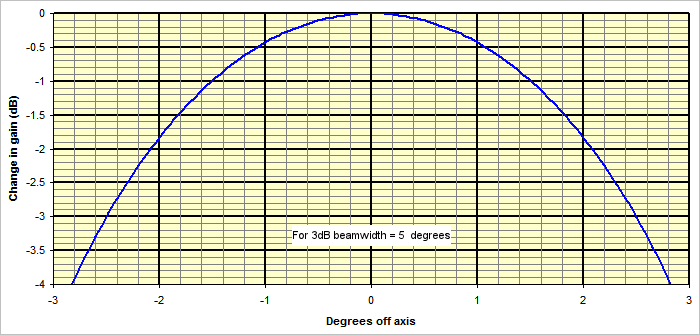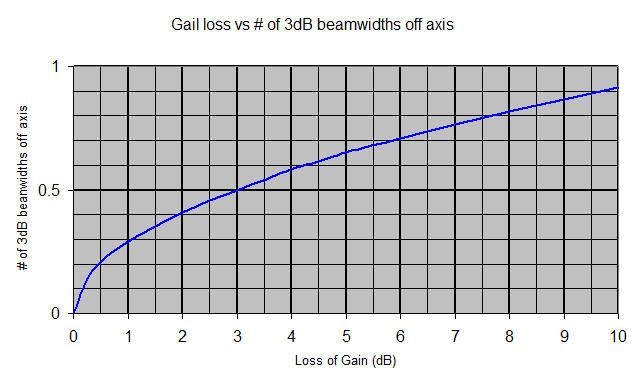EME around New Moon - the Icarus offset

Every (lunar) month the sun and moon get very close in the sky. This is "New Moon" when the moon is (almost) directly between the earth and the sun. If the alignment is exactly correct, we get a solar eclipse, but most of the time the alignment is such that the moon passes very close to the sun, but not in front of it. The sun is s very strong emitter of electromagnetic radiation, including all radio frequencies. Clearly this makes EME operation difficult because the noise from the sun can overwhelm weak EME echoes.
How much interference the sun causes depends on how close the moon gets to it and the beamwidth of the antenna in use. If the moon is 3 degrees from the sun and you have a 3ft dish on 10Ghz with a full 3dB beamwidth of 0.65 degrees, the sun noise isn't going to cause a problem. However if this same dish is used at 1296MHz, where the full 3dB beamwidth is around 5.2 degrees, then you will see significant sun noise when pointing at the moon.
You might think there's nothing you can do about this other than wait a day for the moon to move past the sun, but in fact that's often not your only option. You can move the dish off the moon (in the direction away from the sun) and get a better SNR on echoes. Under some conditions you can get a MUCH better echo SNR, maybe 6dB better. This all comes from the fact that the gain of an antenna doesn't fall off uniformly with angle. At the center of the bean, gain changes quite slowly as you move off axis, but at the edge of the bean is changes quite fast, as shown below:

Let's look at some numbers for a 3m dish at 1296 MHz
Let's say the moon is 2 degrees from the sun. When the antenna is pointed directly at the moon Dx echoes will be received at full strength, but sun noise will only be 2dB less than with the antenna pointed directly at the sun. Now let's move the antenna by 2 degrees, in the direction away from the sun. The DX echo strength will drop by 2db, but the sun noise will now be 8dB lower then with the antenna pointed at the sun. So although the absolute echo signal strength has gone down by 2dB, the Signal to Noise Ratio (SNR) has improved since the sun noise has gone down by 6dB. So, to a first approximation, the SNR will improve by about 4dB
This isn't just a theoretical exercise. Today (September 25th 2022) the sun and moon were within a few degrees. With the antenna offset by 2 degrees from the moon (in the direction away from the sun), a saw about a 5dB improvement in the SNR of Dx echoes. For example, in one case SNR was -18 when the dish was aimed at the moon, but this improved to -13dB when the dish was offset by 2 degrees from the moon in the direction away from the sun. Note that during a full QSO, you need to point at the moon when transmitting, and only offset the aiming when receiving the DX station.
If you want to play with numbers...
If we assume that the beam profile out to the -10dB points is Gaussian (which is a reasonably good approximation), then the loss of gain vs. the pointing offset (measured in units of the 3dB beamwidth) can be estimated as below"

The reason for the unusual units of "3dB beamwidths" is that the 3dB beamwidth of an antenna is usually known, or for a parabolic dish can be estimated by:
where D is the dish diameter and lambda is the wavelength (measures in the same units, e.g. cm)
So you can see from the graph that if you target is 0.5 Full 3dB beamwidths off the target, the gain loss is 3dB (as you would expect!). So for a 3m dish at 1296, where the 3dB beamwidth is about 5.2 degrees, if you are beaming 2.6 degrees from the moon, Dx echoes will be 3dB down.
Self echo strength may also improved an offset applied, but the effect was not quite so large. In this case the loss of gain applied to both Tx and Rx, so the Tx ERP in the direction of the moon is lower with the offset aiming, Despite this, the lower sun noise with the dish offset from the moon can result in an overall increase in the SNR of echoes.
While in principle everything can be calculated if the beam profile of the antenna is known (or estimated as shown in the plot above), it's easier just to change where to antenna is aimed and see if SRN improves! In general the technique of aiming the antenna slightly off the moon might be expected to work when the sun-moon separation is similar to the beamwidth of the antenna. If you are using an antenna control program like PStRotator, this is very easy to do.
For want of a better term, maybe this offset should be referred to as a Icarus offset - a need to move away from the sun when you get too close!
.jpg)